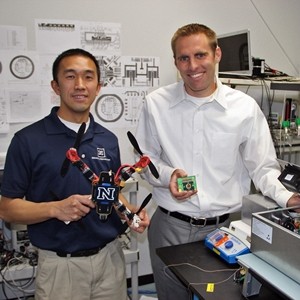6 March 2014. University of Nevada in Reno and NevadaNano, a spin-off company from the university, are developing an aerial robotic device for environmental sensing and reporting over a large area. The project is funded by a $150,000 Small Business Technology Transfer grant from the U.S. Army.
The project combines the university’s expertise in autonomous robotic systems with NevadaNano’s work with microprocessor-based sensing devices. The university’s principal investigator on the project is Kam Leang, a professor of mechanical engineering, and director of the school’s Electroactive Autonomous Systems (Easy) Lab. The lab’s research includes mechanical airframe design, system identification and modeling, and position sensing and tracking.
NevadaNano was founded in 2004 to commercialize research conducted at Nevada-Reno on micro-electro-mechanical systems (MEMS)-based sensor modules. Much of its earlier work was funded by Defense Advanced Research Projects Agency to develop a prototype sensor system for measuring concentrations of unlawful or hazardous materials in ocean shipping containers.
The new project aims to design a self-powered flying robot with chemical sensors and the ability to communicate its readings. The project leaders — Leang and NevadaNano’s Ben Rogers — envision the vehicle being able to send and receive data with other flying robots deployed over a large area, and relay the data to controllers on the ground.
NevadaNano’s lead product is the molecular property spectrometer, a chip-based system with sensors that the company says can measure multiple thermodynamic and electrostatic molecular properties of sampled vapors, liquids, and particles. The system can analyze the various molecules picked up by the sensors and return an identification of the molecules detected.
For this project, the developers aim to integrate the molecular property spectrometer into a drone designed by Leang’s lab. In its current configuration, the molecular property spectrometer system fits into a shoebox-size housing for sensing potential threats in shipping containers. For the flying robotics project, the developers aim to shrink the system to about the size of a deck of cards.
The first (and funded) phase of the project runs through July and expects to determine the feasibility of the proposed vehicle. If the concept is adequately proven, the team plans to build and field-test a prototype in phase 2, with a final product developed in phase 3. The developers anticipate the robotic vehicle could be used in military reconnaissance, surveillance, law enforcement, hazardous waste inspection and removal, disaster search and rescue operations, and remote sensing and mapping.
Read more:
- Bio-Inspired Cooperative Robotic Control System Developed
- NSF-Funded Research Studying Robot-Human Interaction
- Inexpensive Robotic Power Line Inspection Device Developed
- Tiny, Winged Manueverable Robotic Insects Created, Tested
- Robotic Bat Wing Developed to Simulate Flight Dynamics
* * *


 RSS - Posts
RSS - Posts
You must be logged in to post a comment.